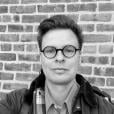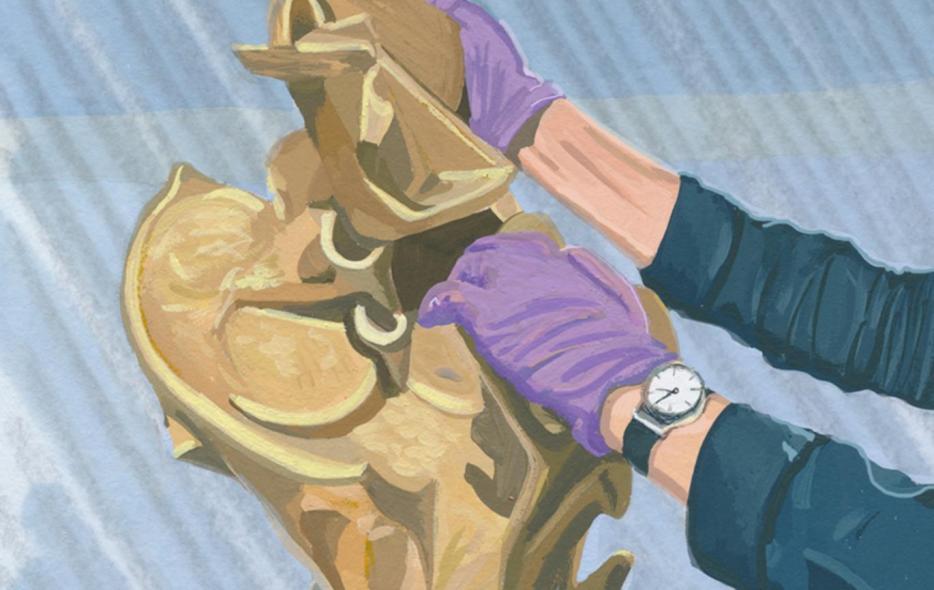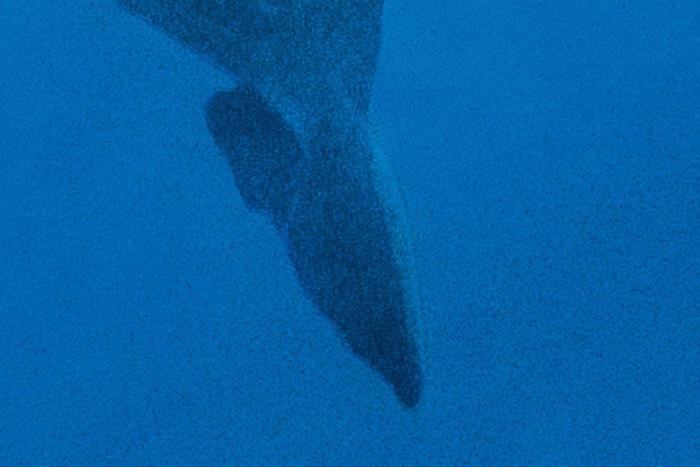In September of 2022, I went to the Metropolitan Museum of Art in New York City to conduct research on figurative representations of bodies in motion. While there, I wrote a small book about a bronze sculpture from 1913, about the shapes that my own body makes while it moves, and about an uneasy mirroring between myself and this bronze statuette. I had been, and remain, interested in the ways in which the shapes of the body change as it moves within the spaces of the world, and how those shapes are reordered according to the material behaviours of the body itself.
I did not know, when I arrived for my twelve-month fellowship at the museum, that my life would be indelibly organized by the adoption of this bronze figurine, and the ways that myself and the bronze would go about dreaming in one another’s strange company.
I have long found the physical movements of bodies deeply, inordinately, fascinating. Perhaps it is partly because, since the age of eleven, I have performed irregular movements and made loud noises within numberless spaces, because I am a person who lives with Tourette’s Syndrome, a neurological disorder that causes involuntary tics, convulsions, movements, and utterances.
For me, Tourette’s Syndrome presents a lived scenario where I am two ways at once: My body is the body making the movement or utterance while also being the body watching the movements being made and hearing the sounds coming out of it. A body like this is both an actor—the producer of its own motions—and a witness to those same actions from a forced remove.
I am a person with Tourette’s Syndrome, and I am also a writer and an artist. While these attributes do not necessitate a direct relationship—and I want to make it clear that sometimes they do not—over time I became interested in relationships that I observed between artistic representations of bodies engaged in motion and my own body, which is constantly pressed into movement through the disorderly neurological scenario I find myself in.
As a graduate student, I became interested in artworks in which I sensed a strong relationship between a depicted body (the figure) and the particular spot it was placed (the ground), whether that was a landscape, a room, or some more amorphous kind of space. During that time, I looked very closely at paintings where I found these figure-ground relationships acutely present, finding my own hermetic classics of the form in pictures like Francis Bacon’s Van Gogh in a Landscape, or Kazimir Malevich’s Running Man.
Both of these paintings feature a human figure in transit through a landscape, where the walking or running body seems somehow alien to itself. In looking at them, I read a complicated discord between the whole and the parts of the figure; between its form and the action of its movements. For me, these formal relationships between figure and ground—between a body and the world it occupies—revolved around a preoccupation with the material silhouette that a body throws against the world. I found that I began to physically sympathize with the figures I was studying in artworks. I felt the shapes and the moves of my own body in tandem with the gestures and postures I observed in paintings, sculptures, and photographs. The constructed figures populating art objects were helping me to feel out my own living form through the expression of the many shapes they had been pressed into.
Before going to New York, I had seen photographs of Umberto Boccioni’s Unique Forms of Continuity in Space and had admired it—if dubiously, given Italian Futurism’s enthusiastic participation in the rise of Fascism. Still, I found its shapes and materials overwhelmingly lush and odd. Boccioni wished to make the movements of a figure part of that figure’s contours and form. The movements of a body, instead of being ephemeral actions, would now be fixed material volumes—carried within the figure in permanence.
It was after my initial in-person encounter at the Met that the piece became something more remarkable for me. In it, I found a profusion of movements shaping a body, and this amassment of gestures felt familiar. Tourettics often report having a set array of tics, of involuntary movements and outbursts. Within some circles, this is called a Tourettic repertoire. My own repertoire, for instance, contains nineteen tics that I can describe in meticulous detail, and that I will likely repeat in some form for the duration of my life. Two bodies, Unique Forms and my own, can be interpreted as containers for pre-set movements, as figures whose repeated actions reorganize their shapes in space.
When I encountered Unique Forms of Continuity in Space at the Met, within the roundness of life, I saw an organization of glistening movement, a construction of parts that shuddered endlessly beneath the museum lights while somehow remaining always still. It stood up there just in front of me, a fluttering metal paradox, and in bronze folds I saw and felt my own convulsive daily life. I saw my abdomen binding harshly inward while air leaves my mouth in frantic gusts, while my arms move with force against the bumps of my ribs, at the grocery store (I had been choosing a lemon). I saw and I felt the muscles of my buttocks, thighs, low-legs and feet cycling through tense gestures as I sit on subway cars.
My profession is made by dividing attention between writing, artmaking, and research. I am a person who works with words in close proximity to pictures and objects, and this is important to remember when I try to talk about Tourette’s Syndrome as I experience it. Writing in relation to images and objects often means describing images and objects with words, and the granular description of the shapes and volumes of the body in motion are a common occurrence in accounts of people with Tourette’s Syndrome. In Means Without Ends, the Italian philosopher Giorgio Agamben described Tourette’s as:
…a proliferation that cannot be defined in any way other than as a generalized catastrophe of the sphere of gestures. Patients can neither start nor complete the simplest of gestures. If they are able to start a movement, this is interrupted and broken up by shocks lacking coordination and by tremors that give the impression that the whole musculature is engaged in a dance…that is completely independent of any ambulatory end. [1]
Describing a patient under observation, Georges Gilles De La Tourette reported that,
Without apparent provocation, S… would exhibit a series of singular movements which at times were localized, at others generalized, sometimes they affected one side of the body, sometimes they affected both. Such movements were rapid…the outer ear and the corners of the mouth which would suddenly be drawn upwards and outwards; a whole series of grimaces was observable, none of which involved the eyes or tongue. Associated with such grimaces were very fast upward swinging movements of the arms and alternate bending and straightening of each leg such that the right foot especially would stamp against the ground. At the climax of this bizarre collection of movements S… would let out a harsh, inarticulate cry. [2]
I am also made to move and make sounds I did not intend to make. The “harsh inarticulate cry” that loudly animates the last scene could very well be my own.
Gilles de la Tourette’s description, taken from his case studies circa 1885, constructs a body in motion via the language of medical observation, a language of study. Developing symptoms as a child (as I and many others like me did and do) means forming a very direct relationship with words as a means of construction via the procedures of assessment and diagnosis, where efforts are made to render the body and the actions of the body and the brain as itemized and observable phenomena. As an eleven-year-old, this schematization of the sensations and emotions and the material of my body through words and description made me familiar with its power to render the body as a set of formal conditions; as a system of parts and materials, as an object that either did or did not function according to median expectations. I became familiar with the way words can determine the existential dimensions of a given body.
Much of my initiation to these language-worlds of diagnostic process came about in the waiting rooms of children’s psychiatric wards. All the chairs were done up with pale brown pleather, every seat beaten with sweat, with boredom, with generations of flatulence. The words bobbled out towards me from the deep-swallowing mouths of specialists. I became used to the chore of looking at myself in dulled horror through the faded eyes of medicine’s available representatives.
A body that acts while watching itself act is a body encountering itself as an object, encountering itself as one might encounter a picture, or a sculpture; things that ask to be described from without. This means that if I encounter myself at regular intervals as a series of observable volumes and shapes moving in space, then I may be able to leverage my encounters with Unique Forms of Continuity in Space to elaborate on my understanding of how my own body is and what it does in the spaces of the world. In my work at the museum, I set out to use Unique Forms of Continuity in Space as a kind of scaffold for telling a story about being a body that will not stay still.
It seems useful to note the Tourettic body’s propensity for outrage. My body moves and makes sounds that are less than preferable, either as relates to the context they are performed within, or the content communicated through that performance. Tics are something like a series of energetic leakages, moments where the excessive qualities of experience take spontaneous form within a body. As British neurologist Oliver Sacks once wrote:
…it is felt, by insightful patients, as questionable and paradoxical: ‘I have too much energy,’ one Tourette patient said. ‘Everything is to bright, too powerful, too much. It is a feverish energy, a morbid brilliance.’ ‘Dangerous wellness’, ‘morbid brilliance’, a deceptive euphoria with abysses beneath—this is the trap promised and threatened by excess… [3]
If I seek to describe my life here, with my symptoms in focus, I can say that I live a life punctuated by outbursts, that I live in a body that jolts over various acknowledged lines of behaviour and appropriate conduct, a body that is excessive with itself, shuddering, compulsively scatological, inventive, full with energy, a body moved by a kind of breathless freneticism that is applied to all things and repeated over and over. Tourette’s Syndrome means that I routinely encounter my body as an object while still being inside of myself. I wanted to push this removal a step further, I wanted to exaggerate this process—I wanted to know what could be gained from adopting Unique Forms of Continuity in Space as a figurative proxy, as a readymade armature for exploring states of embodiment.
On April 19th of 2023, I received permission to touch Unique Forms of Continuity in Space, uninterrupted, for a half hour, with gloves on. This permission was the result of patient months of interdepartmental emails, queries, verifications, and clarifications. It is a singularly novel experience to quietly and insistently pursue an action (making physical contact with Unique Forms, one of the major works of European Modernism) within an institution the size of the Met while having only the vaguest explanations to offer regarding one’s desires and expected outcomes. This was research of the most breathless variety.
Finally, I could follow all the dynamic lines and volumes of this figure that moved so much while staying still; follow them with my hands, my hands that actually moved. The real movements of my own body would meet with the simulated heap of movements comprising Unique Forms of Continuity in Space, each animating the other.
On a limpid day in April, my hands found the places where Boccioni’s hands had been in 1913. My own fingers reached for the recorded depressions of his thumbs, for all the pieces that were shaped in a series of hand-sized grabs and holds, for the stretches where the longer lines tapered down—all the places where he would have smoothed the plaster under grazing fingers.
I left the museum and Unique Forms of Continuity in Space did not leave with me. The bronze statuette did not walk out, or stride, or bound down the steps. The bronze did not leave with me, perhaps hand-in-hand and under full sun, bluebird skies, because Unique Forms of Continuity in Space does not truly move, could not really live in the round spaces of the world, as I live in them.
Instead, Unique Forms of Continuity in Space lives in the rounded world of my blushing heart and in the landscapes of my brain. After all this time together, how could it be otherwise? “…those things impossible being hauntingly possible, times when what had seemed unreal was proved to be real…the power of love to alter inanimate things and make them live,” as Marguerite Young wrote in her 1965 novel, Miss MacIntosh, My Darling.
Unique Forms of Continuity in Space carries on vibrantly in my long-held interests. I am interested in the appearances of the body being upset by the behaviours of the body. I am concerned with instances where the appearances of the body—the sensible surfaces, the living veneers of the body in space—are upset and interrupted by the material activities of the body.
My experience of Tourette’s Syndrome remains, for me, a figurative experience, a position in the world that places me in a figurative flux. The spaces beyond the museum—like the room I write this in, or public buses, pizza shops, sidewalks, grocery queues, the worn seats in cars—in these disruptive moments, become a ground for the figure that I am, or will soon be. I watch attentively, and from the closest distance.
[1] Agamben, Giorgio. “Notes on Gesture” In Means Without Ends: Notes on Politics, 49-62.
[2] Georges Gilles De La Tourette. “Study of a Nervous Affliction Characterized by Motor Incoordination with Echolaha and Coprolalia Jumping, Latah, Myriachit.”
[3] Oliver Sacks. The Man Who Mistook His Wife for a Hat.





